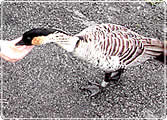 The value of zoos
The value of zoos
Captive Breeding programmes:
Most zoos now have captive breeding programmes which have a number of important benefits:
- Fewer animals need to be caught in the wild and transported to zoos.
- Reduced pressures on wild stock so lessening the chances of extinction.
- Successful captive breeding allows the possibility of the species being reintroduced back into the wild.
For successful breeding, the following recommendations are normally applied:
- Every individual should be encouraged to mate except for very close relatives.
- Each breeding animal in each generation should produce an equal number of offspring.
- Reintroduction of animals from zoos back into the wild.
- Research and logging of genetic diversity in wild and zoo populations.
- Monitoring of genetic health of the species by genetic fingerprinting.
Captive breeding can encounter the following problems:
- Poor zoo records to guide breeding programmes. Inbreeding may occur and can cause loss of fitness and ‘inbreeding depression’, which leads to infertility.
- Some animals will not breed in captivity.
- Social behaviour within some species makes widespread breeding difficult to achieve.
- As no single zoo can maintain the large numbers of individuals to sustain the entire species, international zoo cooperation is essential.
- Collection of viable sperm may be difficult – some wild animals will not cooperate!
- Females must be ‘on heat’ when the sperm is available, which can be difficult to assess.
Reintroduction programmes:
There have been a number of notable successes with reintroduction programmes, although here have also been failures and difficulties. Use the following links to investigate some of these examples (why do some succeed whilst others fail?):
Research :
Zoos provide an environment in which wild species can be studied in more detail than in their wild habitat. Research in zoos also yields vital information about the reproduction and genetic biology of endangered species.
 Research in Chester Zoo
Research in Chester Zoo
Education:
(taken from Conservation – the World in our Hands – Bristol Zoo – Stephen p. Woollard.)
 In the end we will conserve only what we love and respect.
In the end we will conserve only what we love and respect.
We will love and respect only what we understand.
We will understand only what we are taught or allowed to experience.
Bab Dioum – Senegalese conservationist.
If conservation is to succeed we have to inspire and educate everyone to care about wildlife and wild places. TV is an excellent medium for information but it is an edited version of reality. A TV picture does not convey an animal’s size, texture, smell or the simple wonder of being close to a live animal.
Zoos are a unique educational resource and they are the only place where most people will se, hear and smell living wild animals form all over the world.
50% of zoo visitors are children.
 Zoo activities
Zoo activities



 The value of zoos
The value of zoos
What's your opinion?
Average rating




Not yet rated